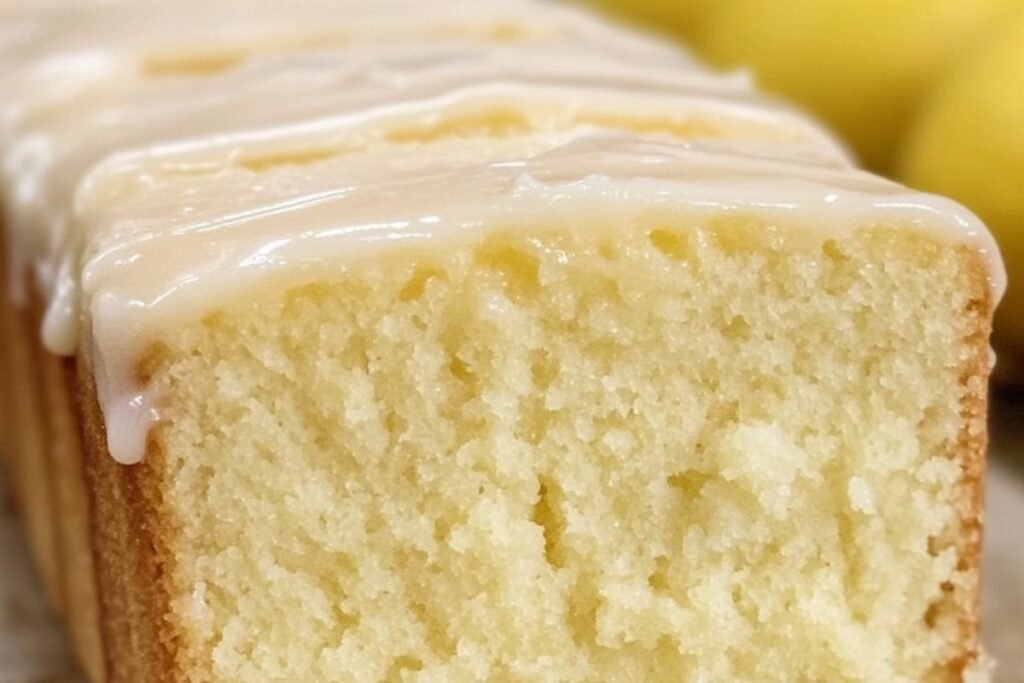If you’re searching for the ultimate dessert to brighten up your day, look no further than the Glazed Lemon Pound Cake Loaf. This classic loaf cake is bursting with zesty lemon flavor, balanced by a tender crumb and a luscious, sweet glaze that ties everything together beautifully. Whether you’re making it for a cozy afternoon tea, a holiday gathering, or just a delightful snack, this pound cake recipe is a true crowd-pleaser.
In this extensive guide, we’ll explore everything about this delicious Glazed Lemon Pound Cake Loaf — from the ingredients that make it so irresistible, to detailed baking tips, variations, and even expert troubleshooting. Plus, you’ll get a full FAQ section and a clear, easy-to-follow recipe to ensure your baking success.
Why Choose This Glazed Lemon Pound Cake Loaf?
Pound cakes are beloved for their simple ingredients and rich texture. The Glazed Lemon Pound Cake Loaf stands out because it blends the classic buttery richness of pound cake with the fresh, vibrant punch of lemon. The citrus zest and juice brighten the flavor, while the smooth glaze adds a perfect sweetness and slight tang.
Unlike other cakes that can be overly sweet or dry, this recipe creates a moist, tender crumb thanks to the addition of sour cream and balanced leavening agents. And the glaze? It’s the finishing touch that transforms this loaf into a showstopper.

Ingredients Breakdown: What Makes This Cake So Good?
Let’s dive deep into the ingredients, understanding their role and why they matter:
Butter (½ cup softened)
Butter is the backbone of this pound cake, providing richness and moisture. Using softened butter ensures it creams smoothly with sugar, creating a light, airy base for the cake.
Granulated Sugar (1 cup)
Sugar isn’t just for sweetness. It helps tenderize the crumb by interfering with gluten formation. The granulated sugar also assists in achieving a beautiful golden crust.
Eggs (3 large, room temperature)
Eggs act as a binder, giving structure and moisture. Room temperature eggs mix better with the butter and sugar, helping the batter become smooth and fluffy.
Lemon Zest & Juice (2 tablespoons zest, 1 tablespoon juice)
This duo is where the cake gets its signature bright flavor. The lemon zest contains aromatic oils that provide an intense lemon aroma, while the lemon juice adds tanginess and acidity to balance the sweetness.
Vanilla Extract (2 teaspoons)
Vanilla enhances the flavor profile, rounding out the lemon’s sharpness with warm, mellow notes.
All-Purpose Flour (1½ cups)
Flour gives the cake structure. The right amount is crucial; too much flour makes the cake dense, too little makes it fall apart.
Salt, Baking Soda, and Baking Powder (¼ teaspoon each)
These act as leavening agents and flavor balancers. Baking soda and powder ensure the cake rises properly, while salt sharpens the overall taste.
Sour Cream (⅓ cup, room temperature)
Sour cream adds moisture, richness, and a subtle tang that complements the lemon perfectly. It also contributes to the tender crumb.
The Art of Making the Perfect Glazed Lemon Pound Cake Loaf
Step 1: Preparing Your Oven and Pan
Set your oven to 350°F (175°C). Grease and flour a 9×5-inch loaf pan or line it with parchment paper. Proper preparation ensures the cake releases easily after baking, preserving its perfect loaf shape.
Step 2: Mixing Dry Ingredients
Whisk together your flour, salt, baking soda, and baking powder. This ensures even distribution of the leavening agents throughout the batter for a consistent rise.
Step 3: Creaming Butter and Sugar
Beat the softened butter with granulated sugar until light and fluffy. This step is essential for creating a light texture, as it incorporates air into the batter.
Step 4: Adding Eggs and Flavorings
Add eggs one by one, beating well after each addition. This slow incorporation helps stabilize the mixture. Then mix in the lemon zest, juice, and vanilla extract until combined.
Step 5: Combining Wet and Dry
Alternate adding dry ingredients and sour cream to the batter, beginning and ending with the dry ingredients. Mix gently to avoid overworking the batter, which can make the cake tough.
Step 6: Baking the Cake
Pour the batter into the loaf pan and smooth the top. Bake for 50-55 minutes or until a toothpick inserted into the center comes out clean. Let it cool for 10 minutes in the pan before transferring to a wire rack.
Step 7: Making and Applying the Glaze
Whisk powdered sugar, lemon juice, and melted butter until smooth. Drizzle over the completely cooled cake and let it set before slicing.
Tips for the Best Glazed Lemon Pound Cake Loaf
- Use fresh lemons for zest and juice to maximize flavor.
- Don’t skip the sour cream; it’s key to moistness.
- Avoid overmixing the batter — it keeps your loaf tender.
- Let the cake cool completely before glazing to prevent the glaze from melting.
- For extra lemony punch, add a little lemon extract to the batter.
Variations to Try with Your Lemon Pound Cake Loaf
- Blueberry Lemon Pound Cake: Fold fresh or frozen blueberries into the batter for a fruity twist.
- Lavender Lemon Pound Cake: Add 1 teaspoon dried culinary lavender for a fragrant floral note.
- Lemon Poppy Seed Pound Cake: Stir in 2 tablespoons poppy seeds for texture and flavor.
- Glaze Variations: Try orange juice instead of lemon for a sweeter citrus glaze.
Nutritional Information
Each slice of this Glazed Lemon Pound Cake Loaf contains approximately 300 calories, making it a moderate indulgence you can enjoy guilt-free with your afternoon coffee or tea.
How to Store and Serve
Store your Glazed Lemon Pound Cake Loaf in an airtight container at room temperature for up to 3 days or refrigerate for up to a week. This cake also freezes well — wrap it tightly in plastic wrap and foil before freezing, then thaw overnight in the fridge.
Serve it sliced with fresh berries, whipped cream, or a scoop of vanilla ice cream for an extra special treat.
Frequently Asked Questions (FAQs) About Glazed Lemon Pound Cake Loaf
Q1: Can I use cake flour instead of all-purpose flour?
Yes! Cake flour will give your pound cake a lighter, softer texture. Substitute it 1:1 but reduce the leavening agents slightly.
Q2: How do I make this cake dairy-free?
Replace butter with a dairy-free margarine and sour cream with a coconut-based or plant-based alternative.
Q3: Can I make this cake without eggs?
Eggs help with structure, but you can use egg substitutes like flaxseed meal or applesauce, though texture may vary.
Q4: How long does the glaze take to set?
About 10-15 minutes at room temperature, depending on humidity and glaze thickness.
Q5: Can I double this recipe?
Yes, just double all ingredients and bake in two loaf pans or a larger pan, adjusting baking time accordingly.
Q6: What’s the best way to zest a lemon?
Use a microplane grater or a fine box grater to get the zest without the bitter white pith.
Conclusion: Why This Glazed Lemon Pound Cake Loaf Should Be Your Go-To Dessert
In the world of baked goods, few treats offer the perfect blend of simplicity and sophistication like the Glazed Lemon Pound Cake Loaf. This loaf cake is moist, bursting with fresh lemon flavor, and topped with a sweet glaze that will satisfy any sweet tooth. Its easy preparation makes it ideal for bakers of all skill levels, while its elegant taste impresses even the most discerning guests.
By following this detailed recipe and tips, you can bake a loaf that’s not only delicious but also visually stunning and perfect for any occasion. The balance of tart and sweet, dense yet tender crumb, and the luxurious glaze make this pound cake stand out among other lemon desserts.
So why wait? Gather your ingredients, preheat your oven, and treat yourself to the incredible delight that is the Glazed Lemon Pound Cake Loaf. It’s a recipe that will keep your kitchen smelling amazing and your guests coming back for more!
